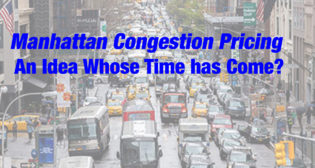
Amtrak’s vision must navigate the money trap
Written by William C. Vantuono, Editor-in-ChiefOne might better predict the 2016 presidential nominees as to forecast what Congress, states, municipalities, and even the private sector will deliver for Amtrak this year, next, and years following.
Consider the recent comment of House Transportation & Infrastructure Committee Chairman Bill Shuster (R-Pa.), whose lukewarm support for Amtrak is many degrees warmer than that of most Republicans who control the House: “Across the country, I have seen the need to fix our nation’s ports, bridges, tunnels, and rails; however, we recognize that we do not have unlimited funds, so we need to focus on what makes sense and prioritize investment in infrastructure that we know is achievable. High speed rail, while great in theory, is not realistic given the Northeast Corridor’s immediate need for state-of-good repair improvements.”
Shuster has a telling point in an era of troubling federal deficits and a strong national consensus to cut federal spending. Indeed, Amtrak President Joe Boardman says that just to keep up with current and backlogged Northeast Corridor maintenance requirements—much of whose infrastructure is between 80 and 150 years old, such as bridges, catenary, and tunnels—Amtrak requires $782 million annually (separate from capacity increases, high speed and higher-speed initiatives). “We are eating our [existing] assets alive,” Boardman said.
Beyond keeping the railroad in good repair on the Northeast Corridor—and Amtrak is hardly assured even the $782 million from Congress needed for that this year—Amtrak’s 21st century vision, especially among budget hawks, is frightfully expensive.
The vision is to expand train capacity and cut travel times between Washington, D.C. and New York, and between New York and Boston, to 94 minutes on each segment—from the current respective 160 and 214 minutes—which will require $151 billion (that’s with a “b”) in additional spending by 2040.
The vision—realistic in that 18% of the nation’s population lives along the Northeast Corridor, Amtrak’s rail/air market share has risen to 76%, and the population is projected to grow by 30% by 2050—is not without a business and financial plan, which Boardman calls a “stair step” process, meaning incrementally and with a variety of funding sources.
So who can or will supply the $151 billion needed?
House Rail Subcommittee Chairman Jeff Denham (R-Calif.)—curiously an opponent of California’s $68 billion high speed rail proposal, but a Northeast Corridor higher-speed proponent—suggested that the $3.3 billion in federal funds previously allocated to the California high speed project, but not spent, be shifted to Northeast Corridor upgrades. But there are no indications the California High Speed Rail Authority, which won Surface Transportation Board approval June 13 to begin construction on the first 65 miles from Merced to Fresno, intends to halt the project. (STB approval is necessary for the intrastate high speed rail line because it eventually will connect with interstate rail carriers.)
Another source of capital improvement funding could come from states that support 18 separate commuter operations along the Northeast Corridor and whose trains are dependent (with the exception of a short segment between New Rochelle, N.Y., and New Haven, owned by Connecticut and New York) on Amtrak infrastructure, dispatching, and maintenance.
The states of Delaware, Maryland, Massachusetts, New Jersey, New York, Pennsylvania, Rhode Island, and Virginia currently pay less than full-cost recovery user charges for those commuter trains’ access to the Northeast Corridor. Agreements in place vary considerably as to cost recovery, and Amtrak is a minority user of the corridor it owns.
On the 456-mile Northeast Corridor linking Washington, D.C., with Baltimore, Philadelphia, New York, and Boston, Amtrak operates only 153 trains daily, while commuter carriers operate more than 2,000 trains daily.
Interestingly, freight railroads that operate 70 freight trains daily over the Northeast Corridor do pay Amtrak full-cost recovery under negotiated contracts.
Section 212 of the Passenger Rail Investment & Improvement Act of 2008 (PRIIA) created a Northeast Corridor Infrastructure and Advisory Commission—composed of states along the corridor, Amtrak, freight users, and the Federal Railroad Administration—whose task is to agree on a new standardized Northeast Corridor cost-sharing formula for commuter railroads that would pay Amtrak full-cost recovery.
Each commuter operator now using the corridor would be assigned the operating and capital costs incurred for the benefit of that service. The commission already is more than two years behind its statutory timetable for recommendations to be made to the Surface Transportation Board, with a final STB decision and implantation of the new formula required by Oct. 16, 2014.
While the new formula for commuter carriers could substantially increase Amtrak revenue on the corridor (Amtrak declines to speculate on how much), cash-strapped states facing the higher payments could be forced, as a result, to reduce commuter train service. In fact, another section of the PRIIA also requires states, by October of this year, to pay 100% of the costs of state-supported non-corridor intercity trains—all operated by Amtrak under contract—traveling fewer than 750 miles, which is another budget challenge for states facing higher commuter-carrier cost sharing. The federal government will cease providing subsidies to those non-corridor intercity passenger trains come October.
Looking forward—assuming Amtrak’s vision for increased capacity and faster transit times is realized—the time savings could be moot in many cases if connecting commuter and non-corridor state-supported intercity trains are scaled-back as a state-budget trade-off for higher cost sharing. Expect that point to be made by the states, creating a challenge for the Northeast Corridor Infrastructure and Advisory Commission and the Surface Transportation Board should they take a wider view of rail passenger service in the Northeast.
Of course, these states could hike sales and fuel taxes and auto registration fees to cover the higher costs of commuter operations and state-supported intercity rail passenger service, but such efforts are problematic in a political environment where lower-tax advocates heavily influence state lawmakers’ decisions.
Other funding options for Amtrak’s $151 billion vision—beyond more federal dollars—are for Congress to scale back money-losing Amtrak intercity passenger service operating over freight-railroad-owned track.
Denham said recently, “We need to take a realistic look at rail across the nation and where it makes money, where it needs huge subsidies, and then prioritize that within the passenger rail [funding provided by Congress].”
Shuster, meanwhile, has his doubts about Amtrak’s Northeast Corridor increased-capacity, higher-speed vision, saying that while it is “great in theory, [the] immediate need for state-of-good repair” of the existing slower-speed Northeast Corridor is more pressing.
Congress determines the level of Amtrak’s long-haul rail passenger service, and cutting it back to provide more Northeast Corridor funds may not be realistic. Democrats control the Senate, and Commerce Committee Chairman Jay Rockefeller (D-W.Va.) calls such talk a non-starter. Indeed, in 23 of the lower 48 states, intercity trains are the only effective means of public transportation between smaller cities, as commercial bus operators have dramatically eliminated intercity service and short-haul air service is rare.
Amtrak’s vision also looks to public-private partnerships, where real estate developers would participate in designing and building new stations, residential housing above and adjacent to stations, and associated commercial structures. Parties agree that a predictable and reliable source of future federal funding for the Northeast Corridor first would have to be in place.
Important in the debate is that federal funding for Amtrak has been declining in real-dollar terms. Consider that the $1.2 billion voted by Congress for Amtrak in 1980 is equivalent to $2.8 billion in 2012 dollars—a year in which Congress provided Amtrak with half that amount, or $1.4 billion.
Amtrak’s most valuable asset in achieving its vision for increased Northeast Corridor capacity and significantly reduced travel times is President Joe Boardman, whose contract recently was renewed by the Amtrak board for another two years.
Unlike many of his predecessors, Boardman (2008- ) is forthright, non-confrontational, and knowledgeable about railroad operations, rail economics and, especially, congressional politics. He may not be a Graham Claytor—Amtrak’s most storied president (1982-1993), who previously led Southern Railway, was a secretary of the Navy and widely admired on Capitol Hill—but Boardman is proving second only to Claytor in selling to Congress the importance of Amtrak to America’s mobility needs. That’s an intangible asset of substantial value if the vision for high speed rail is to be realized on the Northeast Corridor and elsewhere.



